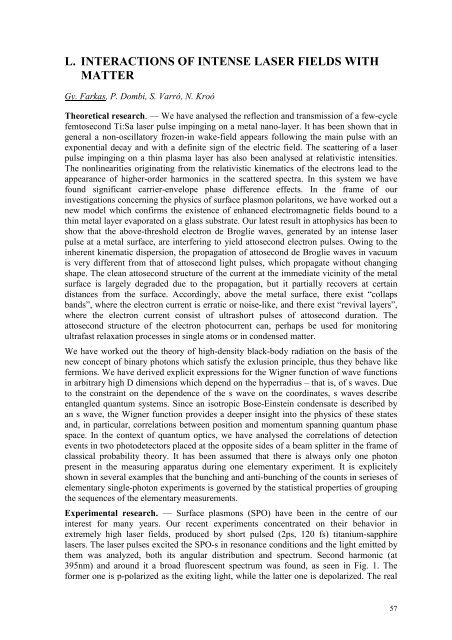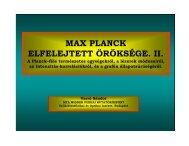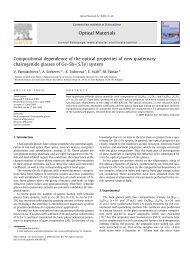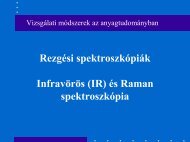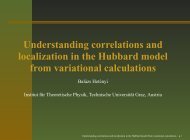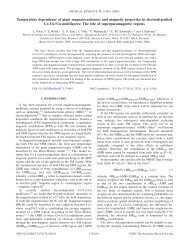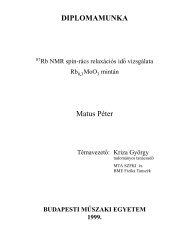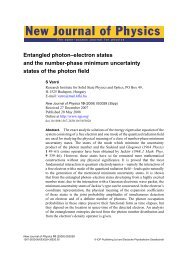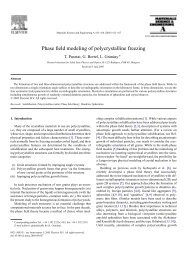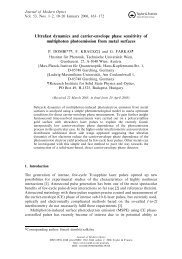ANNUAL REPORT - MTA SzFKI
ANNUAL REPORT - MTA SzFKI
ANNUAL REPORT - MTA SzFKI
Create successful ePaper yourself
Turn your PDF publications into a flip-book with our unique Google optimized e-Paper software.
L. INTERACTIONS OF INTENSE LASER FIELDS WITH<br />
MATTER<br />
Gy. Farkas, P. Dombi, S. Varró, N. Kroó<br />
Theoretical research. — We have analysed the reflection and transmission of a few-cycle<br />
femtosecond Ti:Sa laser pulse impinging on a metal nano-layer. It has been shown that in<br />
general a non-oscillatory frozen-in wake-field appears following the main pulse with an<br />
exponential decay and with a definite sign of the electric field. The scattering of a laser<br />
pulse impinging on a thin plasma layer has also been analysed at relativistic intensities.<br />
The nonlinearities originating from the relativistic kinematics of the electrons lead to the<br />
appearance of higher-order harmonics in the scattered spectra. In this system we have<br />
found significant carrier-envelope phase difference effects. In the frame of our<br />
investigations concerning the physics of surface plasmon polaritons, we have worked out a<br />
new model which confirms the existence of enhanced electromagnetic fields bound to a<br />
thin metal layer evaporated on a glass substrate. Our latest result in attophysics has been to<br />
show that the above-threshold electron de Broglie waves, generated by an intense laser<br />
pulse at a metal surface, are interfering to yield attosecond electron pulses. Owing to the<br />
inherent kinematic dispersion, the propagation of attosecond de Broglie waves in vacuum<br />
is very different from that of attosecond light pulses, which propagate without changing<br />
shape. The clean attosecond structure of the current at the immediate vicinity of the metal<br />
surface is largely degraded due to the propagation, but it partially recovers at certain<br />
distances from the surface. Accordingly, above the metal surface, there exist “collaps<br />
bands”, where the electron current is erratic or noise-like, and there exist “revival layers”,<br />
where the electron current consist of ultrashort pulses of attosecond duration. The<br />
attosecond structure of the electron photocurrent can, perhaps be used for monitoring<br />
ultrafast relaxation processes in single atoms or in condensed matter.<br />
We have worked out the theory of high-density black-body radiation on the basis of the<br />
new concept of binary photons which satisfy the exlusion principle, thus they behave like<br />
fermions. We have derived explicit expressions for the Wigner function of wave functions<br />
in arbitrary high D dimensions which depend on the hyperradius – that is, of s waves. Due<br />
to the constraint on the dependence of the s wave on the coordinates, s waves describe<br />
entangled quantum systems. Since an isotropic Bose-Einstein condensate is described by<br />
an s wave, the Wigner function provides a deeper insight into the physics of these states<br />
and, in particular, correlations between position and momentum spanning quantum phase<br />
space. In the context of quantum optics, we have analysed the correlations of detection<br />
events in two photodetectors placed at the opposite sides of a beam splitter in the frame of<br />
classical probability theory. It has been assumed that there is always only one photon<br />
present in the measuring apparatus during one elementary experiment. It is explicitely<br />
shown in several examples that the bunching and anti-bunching of the counts in serieses of<br />
elementary single-photon experiments is governed by the statistical properties of grouping<br />
the sequences of the elementary measurements.<br />
Experimental research. — Surface plasmons (SPO) have been in the centre of our<br />
interest for many years. Our recent experiments concentrated on their behavior in<br />
extremely high laser fields, produced by short pulsed (2ps, 120 fs) titanium-sapphire<br />
lasers. The laser pulses excited the SPO-s in resonance conditions and the light emitted by<br />
them was analyzed, both its angular distribution and spectrum. Second harmonic (at<br />
395nm) and around it a broad fluorescent spectrum was found, as seen in Fig. 1. The<br />
former one is p-polarized as the exiting light, while the latter one is depolarized. The real<br />
57


